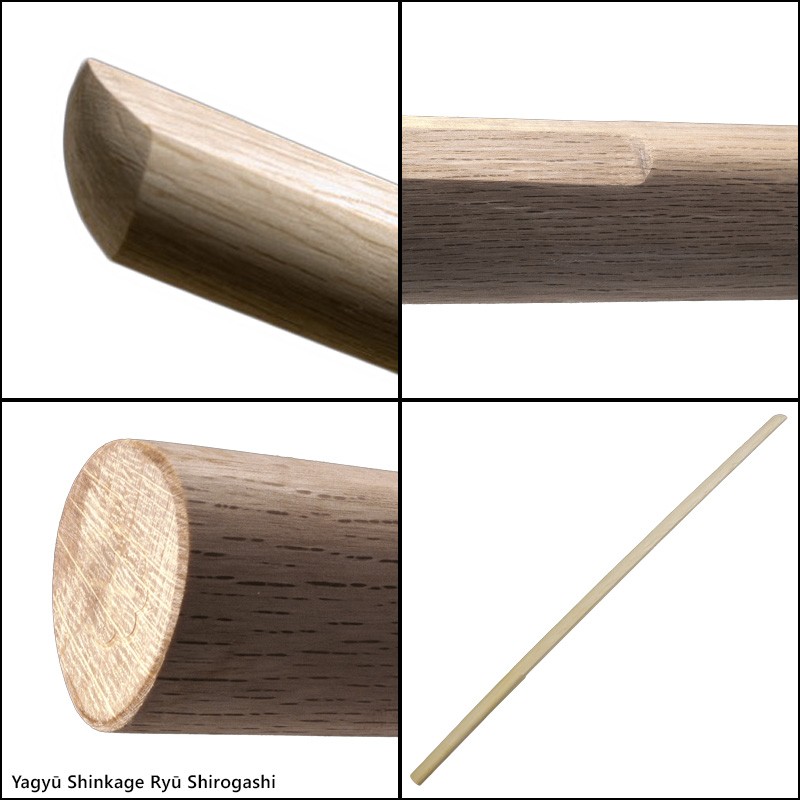

More informations about this product
This Bokken is specific to the Yagyu Shinkage Ryū school 柳 生 新 陰 流, it is suitable for his practice.
The entire product is made of one piece of wood by Aramaki workshops, and especially, not varnished.
This bokken in Shirogashi 白 樫 - White Oak is suitable for all Yagyu Shinkage Ryū practitioners, from beginner to experienced.
With a medium density slightly higher than the Akagashi Red Oak and a high resilience, this species is suitable for solo work, kata or contact.
Cuts are made with the tip only, the bokuto Yagyū Shinkage Ryū is among the finest, the style not intended to block the opponent’s weapon, nor to oppose opponents in Yoroi (armor).
This is the type of bokken used by Master Cognard in his practice of Kobayashi Ryū Aikidō.
Features:
(nb: the production being artisanal, the measurements, especially the weight, can be subject to very slight variations.)
Wood: Japanese White Oak, Shirogashi 白 樫 - し ろ か し
Origin: Kirishima Sankei Forest, Kagoshima Prefecture, South Kyushu.
Botanical Appellation: Quercus Acatussima
Tree growth time before felling for preparation and drying: 70 to 90 years
Shade: Light Ecru / Fiber: Spaced and Airy / Weight: Medium / Resistance: Very good
Aramaki Workshop: “Aramaki Budogu Mokojo” 荒 牧 武 道 具 木 工 所
Miyakonojo, Miyazaki-Ken, Kyushu, Japan (Southwest).
It has existed for 100 years, founded by the Aramaki family around 1920.
Currently led by the 3rd generation Aramaki, Aramaki Yasuo, Artisan name Kazuhiro.
Recognitions, Titles: «Ō-ju Hōshō»* presented by the Emperor of Japan.
(“Ō-ju Hōshō” (黄 綬 褒 章): “Yellow Ribbon Medal” is awarded to “those who, through their diligence in their affairs, have become models for the people.” Created in 1887, it was immediately repealed and only restored in 1955.)
Message from Masamune team: The productions of the Aramaki workshop are incomparable, we consider it as the excellence of the workshops formalized by the Japanese government. In other words, only three official Japanese workshops remain to date and the Aramaki workshop is the only one that can produce enough for export outside Japan.
This workshop has kept a traditional manufacturing method, especially for the selection of wood species and parts, but also thanks to a natural drying that allows to preserve the fibres and the qualities of the wood. This traditional process makes it possible to obtain resistant, robust, pleasant and durable training weapons. The finish of the Aramaki workshop is also remarkable because after the shaping of the weapons using different types of planes, the craftsmen finish the surfacing with very fine sandpaper, giving a feeling of velvet texture.
Masamune Maintenance Tips:
Wooden weapons are ideal training products, but care must be taken, knowing how to preserve and maintain them for optimal safety and preservation. Wood, although "dead", remains a reactive material to variations in temperature and especially humidity.
- Keep weapons horizontally, preserving a stable and homogeneous moisture content throughout the piece of wood.
- Keep in a room that ‘breathes’, avoid cellars, attics, car chests.
- Do not leave near a source of heat, avoid leaving near a radiator, underfloor heating, or too regular exposure to the sun.
- Do not leave near a source of moisture, avoid leaving near entrance doors or windows.
Over time and especially in practice, wood fibres can be subject to alterations, in order to prevent or at least maintain degradation, you can:
- Apply additives such as beeswax or oils (e.g. flax) to the surface with a cloth
- Soak in oil for about 2 to 4 weeks, then ‘dry’ for 2 to 4 months. This process remains quite long and tedious, it adds weight to the weapon and can vary the balance.
- In case of surface deterioration, broken fibre, splinters, sand with sandpaper. Depending on the damage, you will sometimes have to remove a lot of material, then take different grains of paper, from the coarsest (50 to 100) to the finest (600 and more).
Finally, for your own safety, the safety of your partners and those around you, never practice with a cracked or even too fragile weapon. This can cause splinters, or splinters and parts that fly off on contact with another weapon, and injure people around them.
Items that may interest you
Share your opinion
error Your review appreciation cannot be sent
feedback Report comment
check_circle Report sent
error Your report cannot be sent